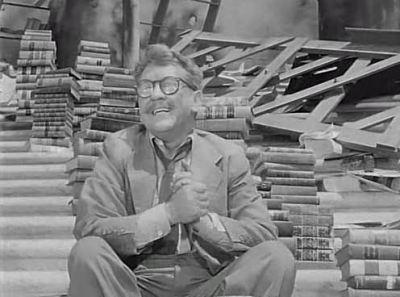This is the dimension of imagination. It is an area we call… The Twilight Zone.

Time Enough at Last
The Guardian pays proper respect to the Twilight Zone:
Watching The Twilight Zone today, it's striking how complex, satirical and thought-provoking it all is. While the tales include such fantastical imagery as a stopwatch that can stop time, department store mannequins coming to life, or a child whose dreams take corporeal form, you can clearly see that they're really about the early-60s: an era of race riots, assassinations, crooked politicians and the Vietnam war, when communism and nuclear bombs were palpable fears. People were confused, scared and paranoid, yet so little of the television of the time reflected this mood. Sponsors, executives, salesmen and producers were in charge of the networks and they didn't want viewers distracted by big issues when they should have been thinking about what products to buy. It was in this climate that 34-year-old writer-producer Rod Serling devised The Twilight Zone. After having almost all the contemporary political references excised from an early drama about a crooked senator, he hit upon the idea of using science fiction and fantasy to smuggle in more controversial elements, in plain sight of the moneymen.
The Twilight Zone is science fiction at its best. It took contemporary themes like nuclear annihilation, themes that could not be discussed publicly, and went at them from a different angle. Serling reshuffled the pieces of reality to show a distorted, but still recognizable, reflection to society. Going directly at something like Soviet paranoia triggers learned responses in an audience, decisions they've made about the world that are now set and part of their beliefs. If the 'Soviets' are transformed into aliens, as in one of my favourite episodes, The Monsters Are Due on Maple Street, viewers give themselves the freedom to look at things differently.
The best contemporary example of this was Battlestar Galactica. Ronald D. Moore took an eighties TV show about space battles against robots (starring Face, no less) and turned it into a meditation of terror and security policy. How many shows on American television do you think could get away with one of the main characters organizing the suicide bombing of an occupying forces' police graduation ceremony in the middle of the Iraq insurgency?
I think Battlestar also perfectly illustrates the hurdles science fiction faces to live up to this part of its legacy. Ask the average person about science fiction, you get Star Wars, lasers and alien chicks of proportions unlikely in any species. This is the most profitable version, so it's the one that's pushed most often. Not to get all nerd-snob, but these aren't science fiction in any real sense, just westerns, fantasies and thrillers that happen to be set in the future.
I nearly fell afoul of this in The Strange Trilogy. Like Serling I wanted to twist reality to draw out some of its threads, in my case religious fundamentalism, security policy, and the various ways people murder one another over abstract ideas. However, as soon as I said it was in the future, even the very near future, people began to expect laser pistols.



